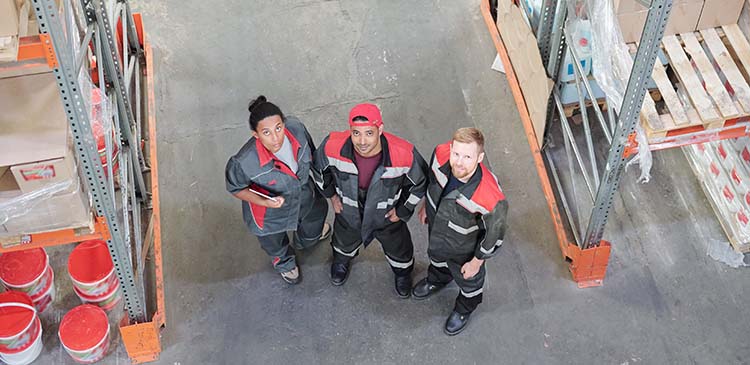Introduction
In the evolving landscape of enterprise mobility, the role of frontline worker devices has become increasingly pivotal. A recent comprehensive study by VDC Research sheds light on the current state and future trajectory of these devices.
This blog aims to provide a summary of the findings, focusing on the key aspects that are reshaping the way frontline workers interact with technology.

The Current State of Frontline Worker Devices
Frontline workers, who form the backbone of industries like retail, manufacturing, and logistics, are increasingly reliant on mobile devices to perform their daily tasks.
The study reveals that these workers, who account for 61% of the global workforce, are now using a wider range of mobile applications than ever before. In North America, for instance, 75% of organizations have their frontline workers sharing company-issued mobile devices, with an average of five unique applications per device – a significant increase from just a couple of years ago.
The dominant operating system for these devices is Android, powering approximately 68% of the devices used by frontline workers. This preference is largely due to the robustness and flexibility offered by Android devices, making them suitable for the varied and often demanding environments in which frontline workers operate.
The Rise in Application Usage
One of the most striking findings of the report is the substantial increase in the number of mobile applications used by frontline workers. From an average of 2.9 applications in 2018, the number has jumped to 5.4 in 2023, marking an 86% increase.
This surge reflects the growing complexity of tasks frontline workers are expected to perform and their need for diverse tools to enhance efficiency and productivity.
Shared Device Model and Its Challenges
The shared device model, where multiple workers use the same device across different shifts, is prevalent in many organizations. This model, while cost-effective and resource-efficient, brings its own set of challenges. The study highlights issues such as shared PINs for device access and individual application authentication requirements, which can lead to inefficiencies and security concerns. Moreover, the lack of insight into device performance metrics and location tracking can hinder effective asset management.

User Experience and Support Challenges
The user experience with these devices is often less than ideal. The report cites examples of service disruptions and helpdesk bottlenecks, primarily due to inefficient authentication processes. The average support call for frontline mobile devices takes about 44 minutes to resolve, with annual support costs averaging $770 per device. These figures underscore the need for more streamlined and user-friendly solutions.
Future Directions and Investment Trends
Looking ahead, the report indicates a clear trend towards increased investment in mobile technology solutions for frontline workers. More than 90% of retail operations technology decision-makers view these investments as a way to make their workplaces more attractive to potential candidates. This perspective is a testament to the growing recognition of the importance of frontline workers and the tools they use.
Organizations are also reevaluating their device strategies, focusing less on traditional workstations and more on mobile solutions that address security concerns and lifecycle management. This shift is accompanied by an emphasis on maximizing the value derived from shared devices, particularly by increasing the number of applications available to frontline workers.
Addressing the Gaps
To fully leverage the potential of frontline worker devices, organizations must address several gaps. These include the need for better configuration capabilities, seamless login solutions, and quality analytics in Mobile Device Management systems. The ability to provide employees with tools to address some issues directly, thereby lessening the burden on help desks, is also a growing necessity.
The future of enterprise mobility lies in recognizing and addressing the unique needs of frontline workers,
Key Takeaways for Businesses
Embrace the Shift to Mobile: Organizations must recognize the shift towards mobile technology as a strategic imperative. Investing in the right devices and applications for frontline workers is crucial for staying competitive and meeting the evolving demands of the market.
Focus on User Experience: The efficiency of frontline workers is heavily dependent on the usability of their devices. Businesses need to ensure that the devices and applications are user-friendly, with minimal learning curves.
Enhance Security and Management: With the increase in the number of devices and applications, security and management become paramount. Implementing robust security measures and efficient device management systems is essential to protect sensitive data and maintain operational continuity.
Invest in Analytics and Support: Leveraging analytics to gain insights into device performance and usage can greatly enhance decision-making and operational efficiency. Additionally, providing effective support and troubleshooting mechanisms can reduce downtime and improve worker satisfaction.
Adapt to Changing Needs: The needs of frontline workers are constantly evolving. Businesses must remain agile and responsive to these changes, regularly updating and upgrading their technology solutions to meet the new challenges and opportunities that arise.
The Road Ahead
The landscape of frontline worker devices is one of rapid evolution and growing complexity. As businesses continue to invest in these technologies, the focus should be on creating a balanced ecosystem where technology enhances, rather than hinders, the productivity and satisfaction of frontline workers. By addressing the current gaps and anticipating future needs, organizations can harness the full potential of their frontline workforce, driving growth and success in an increasingly competitive market.
The study by VDC Research provides valuable insights into the evolving landscape of frontline worker devices. As organizations continue to navigate the challenges and opportunities presented by these tools, the focus must remain on enhancing user experience, improving security, and ensuring efficient management of these devices. The future of enterprise mobility lies in recognizing and addressing the unique needs of frontline workers, who are the key drivers of operational efficiency and customer satisfaction in many industries.
If you would like to download the full report, click here.
The focus should be on creating a balanced ecosystem where technology enhances, rather than hinders, the productivity and satisfaction of frontline workers.
